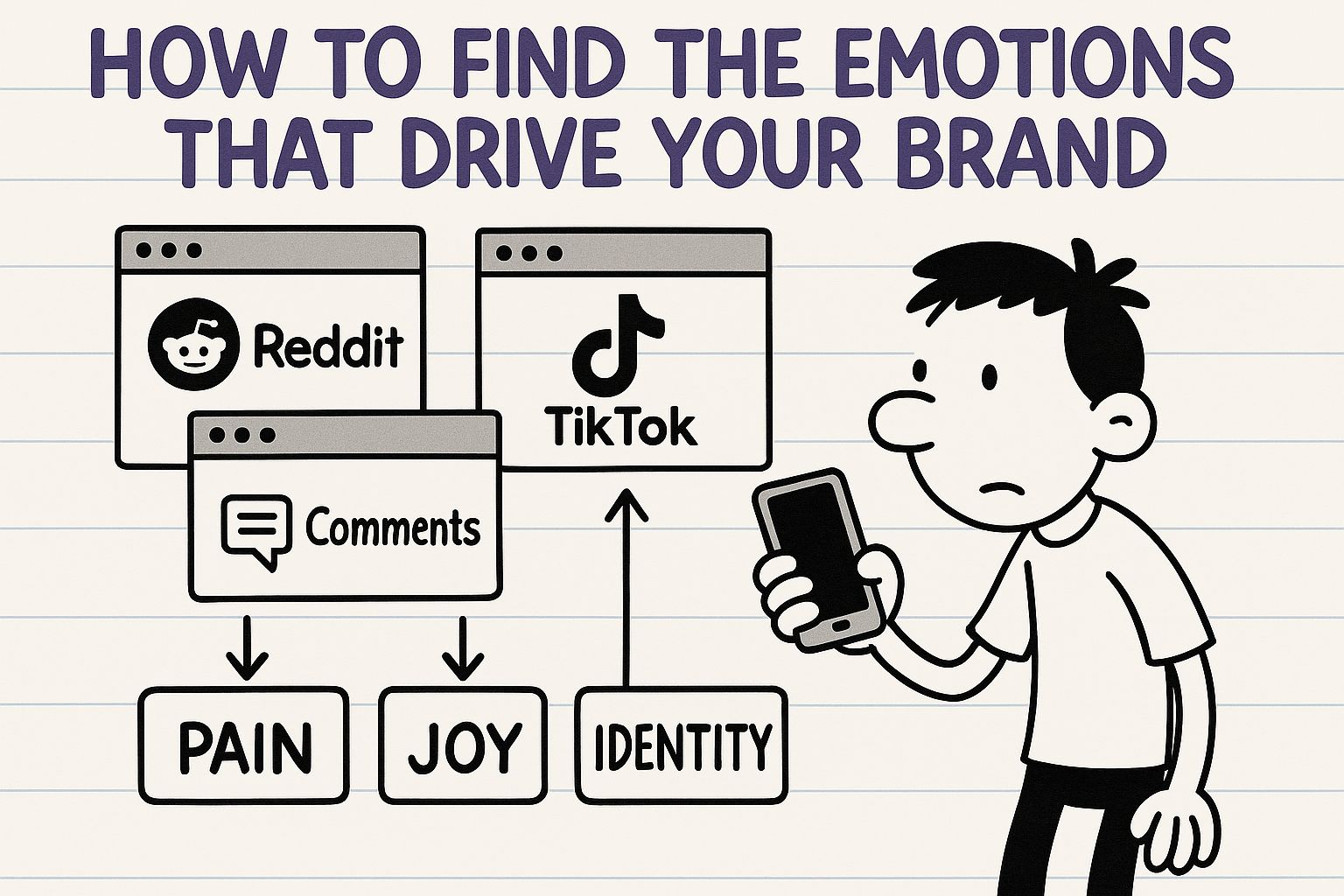What Makes Your Brand Forgettable (and How to Fix It)

Somewhere between the dashboards, the algorithms, and the constant chase for performance, marketing lost something: Soul.
We optimized everything that could be measured: clicks, conversions, attention, and forgot the one thing that couldn’t.
Emotion.
Elizabeth Ahern, Founder of Brand 555 and Former CMO of Chamberlain Coffee has dedicated her career to helping brands find it again.
She believes that in a world obsessed with data, the most powerful marketing variable is still the one you can’t quantify or measure on a dashboard i.e. how the product makes people feel.
It’s why unpolished UGC videos always beat six-figure glossy ads.
It’s why a comment that says “I needed this today” means more than a thousand views.
And it’s why the brands that learn to scale emotion in 2025, will always outperform those who are still trying to scale attention.

Feelings not Facts
We like to think we buy with logic. We don’t.
Neuroscience tells us that every buying decision starts in the limbic system: the part of the brain that processes feeling.
Every choice from the coffee you order, the sneakers you wear, the app you open first in the morning, starts as a feeling.
Experts call it affective priming: when emotion fires first, it shapes the meaning of everything that follows.
And marketers see it every day.
And that’s how they know that any single piece of content that makes people feel something will outperform a dozen that simply explain stuff.
Emotional Matches
When someone sees your ad, their brain doesn’t evaluate the product in the same way a marketer would.
They’re just looking to see if this piece of content or product feels like them.
And that one emotional match builds trust instantly and turns a stranger into a potential customer.
Nike doesn’t sell sneakers. It sells the belief that effort means something.
Red Bull doesn’t sell energy drinks, it sells limitlessness.
Glossier doesn’t sell skincare. It sells the comfort of being effortlessly seen.
These are the invisible layers of branding: the emotional signature these companies leave on someone’s nervous system.
What Happens When You Lead With Feeling
Elizabeth tells her clients that the best marketing meetings do not start with discussions on ad creative, copywriting formulas, or algorithm hacks.
They start with questions like “When someone interacts with us, what do we want them to feel?”
Once you nail that, everything else finds direction. The tone, the visuals, the creators, even the metrics you choose to measure.
Brands that begin with logic chase clicks. Brands that begin with emotion create connection, and that connection compounds.
You see it in the comments from people who say things like “This was me yesterday”
You see it in the customers who stick around even when prices go up.
And you see it in the creators who want to work with you because they believe in your story, not just because you’ve got a budget.
That kind of connection doesn’t happen by accident.
It only happens when you start with conversations about feelings.
Once Upon a Click: How to Tell Stories that Stick

How to Find the Emotions That Drive Your Brand
Before you can tell an emotional story, you need to understand what your audience already feels. Great brands listen before they speak.
According to Elizabeth, here are a few ways to uncover the real emotions behind your category, your product, and your community:
1. Start With Reddit, TikTok, and YouTube Comments
These platforms are the world’s most honest focus groups. Go where people talk without filters.
Search Reddit for your product type or category: “best protein bars”, “skincare routine burnout”, “coffee brand aesthetic”, “I hate my alarm app.”
Then read what people actually say.
- What frustrations do they keep repeating? That is your pain emotion.
- What makes them excited or proud to share? That is your joy emotion.
- What makes them feel seen, cool, or validated? That is your identity emotion.
Exercise — The Emotional Keyword Hunt: Pick three relevant subreddits (for example: r/SkincareAddiction, r/Coffee, r/Fitness).
Copy ten real quotes from people describing products they love or hate.
Highlight emotional words: “finally”, “hate”, “love”, “anxious,” “comfortable”, “confident.”
Group them into three emotion buckets: Pain, Aspiration, Belonging.
2. Mine Your Own Data
If you already have customers, your goldmine is already sitting in your inbox, reviews, and DMs.
Read fifty customer messages and categorize them by tone:
- Excitement: “I can’t believe how good this is.”
- Relief: “Finally something that works.”
- Insecurity: “Wasn’t sure this was for me but…”
- Pride: “I showed this to my friends.”
Count how often each tone appears. The frequency will tell you your brand’s emotional centre.
3. Run a Feeling Audit on Competitors
Watch your top three competitors videos and ads. Ask:
- What emotion are they selling?
- What relevant emotion are they missing?
Maybe one brand sells speed but not belonging. Another sells luxury but not comfort.
Your emotional advantage will often be hidden in what they’re currently ignoring.
4. Listen to the Culture
Every niche has its emotional language. If you sell gym supplements, that language might be discipline, grind, or confidence. But if you sell skincare, it might be self-care, calm, or control.
Look at the memes, the trends, the sounds people use. Each one carries an emotional undercurrent which might be sometimes ironic or sincere. And when you align with the feeling behind the trend rather than the trend itself, you’ll create content that actually resonates with people.
5. Validate Through Micro Tests
Once you have a sense of your brand’s top emotions, test them.
Create two short videos or posts with the same product but different emotional angles.
For example:
Version A: A peaceful morning ritual (emotion = calm).
Version B: A high-energy “let’s go” montage (emotion = motivation).
Whichever one drives more comments like “This feels like me” or “I like this vibe” will reveal your brand’s core emotional driver.

Look Like You Woke Up Like This
We’ve reached the end of the perfect ad era. A decade ago, brands spent millions shooting cinematic social media commercials that looked flawless.
But today, that same polish gets little to no reaction from people.
The content that actually connects now doesn’t look like an ad at all.
It looks like a FaceTime. It sounds like a voice note from a friend. It’s often filmed on an iPhone, lit by a window, and spoken from the heart, not a teleprompter.
It might look “lo-fi,” but it’s what people connect with today.
Today’s buyer is extremely skeptical and can smell fakeness from a mile away.
And every filter, every perfect smile, every over-edited frame says the same thing; this isn’t real.
Audiences today prefer to see the stripped down, bare-bones version of everything. That’s why a creator sitting on their couch can outsell a brand with a full production team.
Elizabeth calls this emotional proximity. It’s that moment when a brand stops feeling like a company and starts feeling like an actual person.
The best-performing content today lives in that space where things are slightly imperfect, but deeply genuine.
A shaky video. A small laugh. A quiet story that feels unfiltered.That’s where it’s at.
And when something feels human, it gets shared. When it feels staged, it gets skipped.
Conclusion
Elizabeth believes the next decade belongs to the brands that care about making people feel a specific emotion .
And it’s absolutely true.
Once a brand understands how to make people feel something genuine, it earns a kind of attention that you just can’t buy.
And when that moment is repeated constantly, that brand becomes part of people’s rhythm. It becomes something they trust, relate to, and keep coming back to.
So as you build, optimise, and plan, keep asking your team:
“What do we want people to feel when they interact with us?”
Because once you know the answer, most of your marketing strategy will write itself.
Build emotion at scale — without losing the human touch.

Most brands already know emotion sells, but few have systems that help them scale it.
Refunnel bridges that gap.
It listens across every platform for UGC, finds the moments that feel real, and helps you turn them into whitelisted ads that move the needle for your marketingl.
From spotting the unfiltered Story your customers post to instantly requesting rights and repurposing it across ads — everything becomes seamless.
Because brands that scale emotion, not just attention, will always win.
Keep On Reading

TikTok Shop Marketing Tips for BFCM

Maximizing Sales on TikTok Shop

